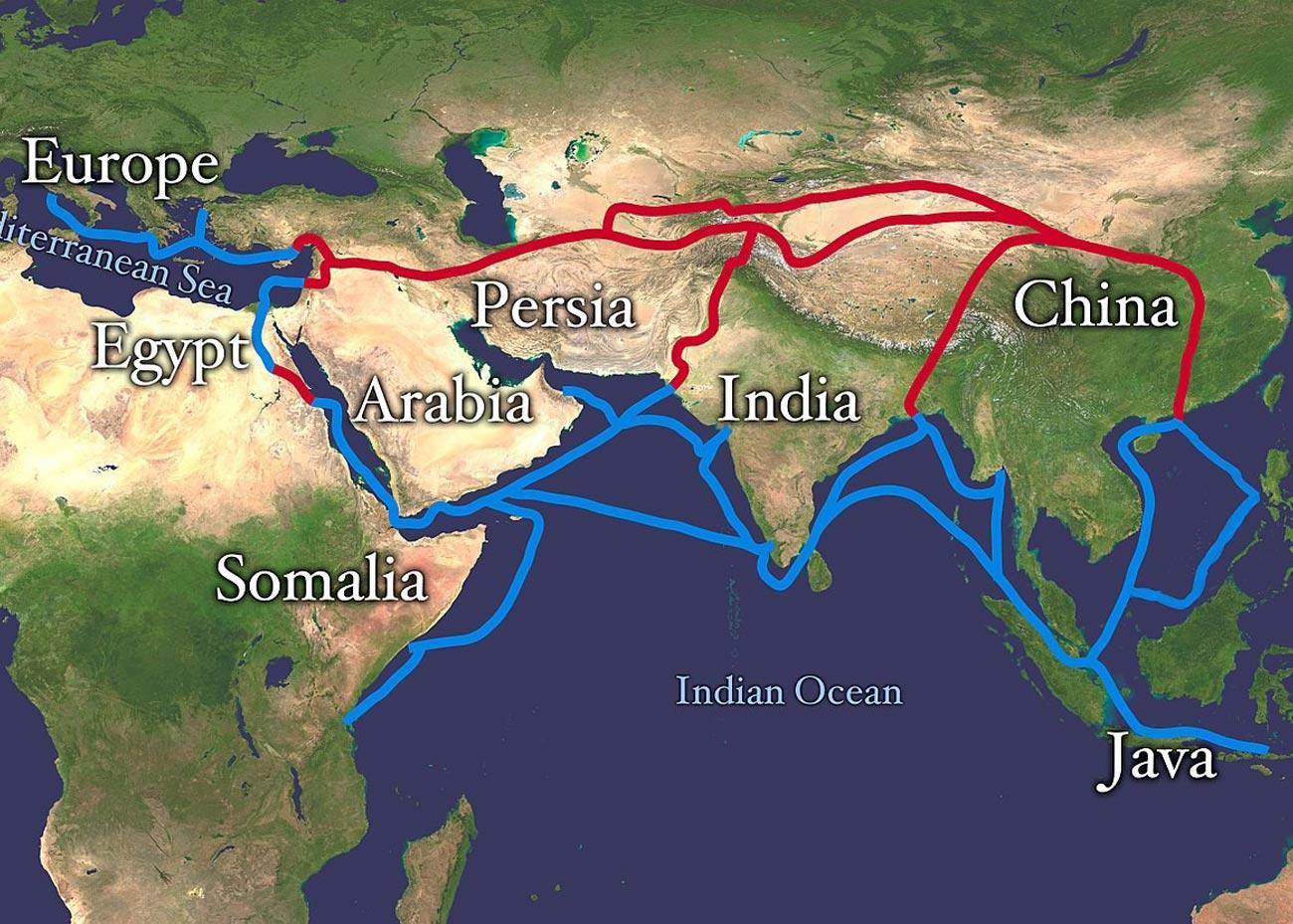Silk Road
Silk Road: the journey between history and modernity
The origins, itinerary and story of the iconic trade route
Few phenomena — except, perhaps, for the religious ones — evoke such strong emotions and cause heated debate like the Silk Road does, despite the fact its story began more than 2,000 years ago. Up until today it preserves its power and meaning, and in the course of the last months its name was often brought up.
The name “Silk Road” was first coined by a German geographer Ferdinand von Richthofen (1883-1905). In the introduction to his “Diaries from China” (Tagebucher aus China, 1877) Richthofen used the term Seidenstraße – which is German for Silk road – to describe from the historic, geographic, social and economic point of view all those caravan ways and trade routes over rivers and seas that connected Oriental Asia (in the first place China), Middle East and the Mediterranean.
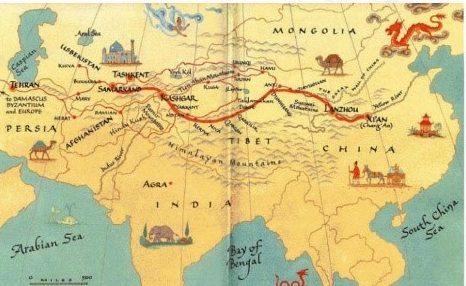 There were at least 5 main trade routes, to which more secondary roads were added over time. The core route started in the ancient Chinese capitals Xi’an and Luoyang, in the Yellow River basin.
There were at least 5 main trade routes, to which more secondary roads were added over time. The core route started in the ancient Chinese capitals Xi’an and Luoyang, in the Yellow River basin.
It crossed the fertile Gansu corridor, reaching western China in the Xinjiang region and then continued to Central Asia and eventually Europe.
Precious products travelling between Europe and the East
Precious stones and spices, perfumes and medicines, cattle and porcelain, jade and bronze, lacquer objects and mirrors arrived in Europe all the way from China and the Middle and Far East. Millet, rice, tea came the same way, as did great inventions that profoundly marked Western history — such as paper and gunpowder.
Silk came in such large quantities that the whole network of routes adopted its name. Silk products — light, easy to transport and highly valued goods, precious by definition — have long been a secret that the Chinese civilization kept to itself.
Silk was paid worth its weight in gold, especially in the Roman period. At a certain point the Roman Senate was obliged to issue specific edicts to prevent its use in order to avoid financial problems. [approfondisci]
The goods also travelled in the opposite direction, from European and Asian countries to China. That included tangible treasures like precious metals and goldwork, cattle — horses, camels and sheep, raw materials — wool, leather and cotton, agricultural products — wheat, green beans, alfalfa, sesame, onions, cucumbers, carrots, pomegranates, grapes, peaches, figs, watermelons. Along came certain religions and schools of thought, such as Buddhism, Islam and Christianity.
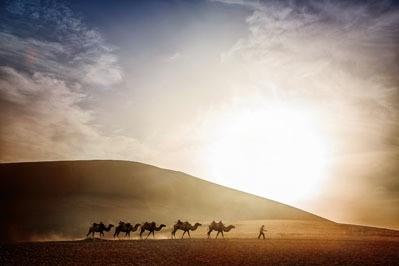 It is believed that the Silk Road started more than 2,000 years ago, when the Chinese economy and society which had been carefully protected and thus unknown to the West, was “opened” at the behest of Emperor Wu of the Han dynasty who ruled between 141 and 87 BC.
It is believed that the Silk Road started more than 2,000 years ago, when the Chinese economy and society which had been carefully protected and thus unknown to the West, was “opened” at the behest of Emperor Wu of the Han dynasty who ruled between 141 and 87 BC.
Trade with the neighboring markets was initiated, followed by the opening of trade routes with Central Asia, which gradually went all the way to Europe.
Further on, the appointment of Zhang Qian as the ambassador of the Empire in Central Asia effectively contributed to the success of this historic period that lasted until 1368 AD. Then, with the fall of the Mongol Yuan dynasty (1279–1368), the communication routes became no longer safe and were gradually replaced by faster maritime trade
Some milestones on the Silk Road history:
- 1000 a.C. – The Shang Dynasty and the merchants of the Yuezhi people of Xinjiang established the first trade routes along the so-called “Gansu corridor”. Silk was brought to Siberia. However, as silky fibers were found in a tomb of an Egyptian pharaoh dating back to around 1070 BC, it is assumed that there had already been trade links along the Southern Silk Road;
- 600 a.C. – The Zhou Dynasty (1045-221 BC) began to trade with Europe: the exported gold, jade and silk. Silk fibers discovered in a tomb in Germany date back to the 6th century BC;
- 138 a.C. – Zhang Qian explored and secured the trade routes that went from Xi’An to the West, eradicating the problem of marauders who had previously attacked caravans on the regular basis;
- 220/581 d.C. – This period is also known as the period of Three Kingdoms. The Han dynasty fell causing social unrest and poor military control, which in turn resulted in a sudden interruption of trade along the Silk Road;
- 618/671 – Tang Dynasty. Turkish tribes that had taken control of the markets and of the silk in particular, were conquered and trade connections with Europe were re-established;
- 629 – Xuanzang — who later became known as the monk who brought buddhism eastwards — traveled along the Silk Road to India, and helped to create conditions for a remarkable growth of relations with the latter. The legend of the “Journey to the West”, one of the classics of Chinese literature, was born;
- 1271/1368 – The legendary Mongolian leader Genghis Khan conquered various small states in Central and Eastern Asia, consolidating the entire territory. He founded the Yuan dynasty with his nephew Kublai Khan. The Silk Road is reopened and the businesses flourish again.
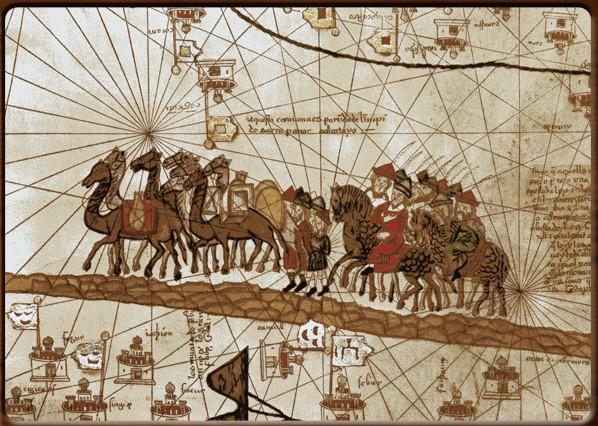
- 1269 –”Here they make a lot of silk”. With these words Marco Polo (1254-1324) describes in his Book of the Marvels of the World the economy of the Chinese province of Cathay. His permits, issued by the Tuan government, became legendary, as he was allowed to move freely in these regions at the historical moment in which businesses reached their maximum splendor: precious stones, spices, perfumes, medicines, cattle, slaves and silk, the latter in large quantities;
- 1368/1644 – The Tuan empire falls and the Ming empire is born. The technique of silk production was by then widespread in Europe, first in Italy and later – around 1400 – also reached France, the district of Lyon. The Ming empire pursues a policy of extreme protection and closes all connections. The trade along the Silk Road is interrupted for good.
The new Silk Road
La nuova Via della Seta più che un progetto rappresenta un sistema complesso attraverso il quale il governo di Pechino intende consolidare e rilanciare l’interconnessione infrastrutturale e commerciale Cinese con il continente Euroasiatico.
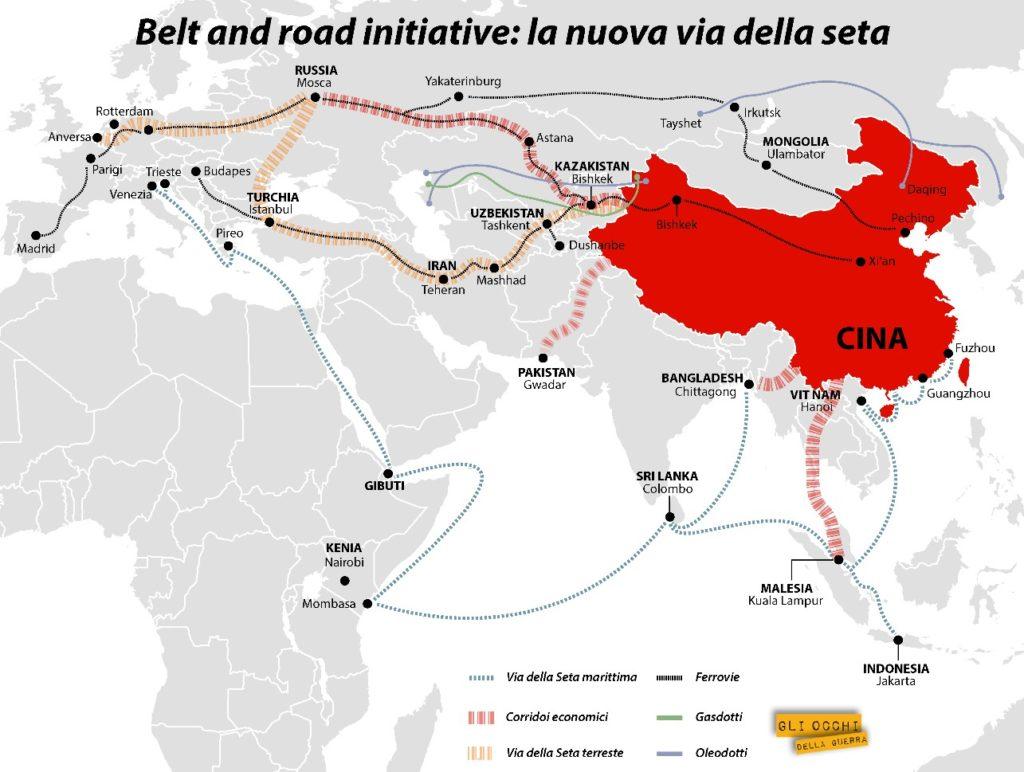
The new Silk Road does not refer to just a single project but rather to a complex system, which Beijing intends to use to relaunch its infrastructure network and reestablish trade connections with Europe and Asia.
The “Belt and Road Initiative” (BRI), also known as “One Belt, One Road” (OBOR), was announced by the Chinese president Xi Jinping in 2013 and is promoted by the minister Li Keqiang. It is often referred to “The new Silk Road“, in order to bring to mind the times of dynamic trade when silk represented the core of that great expansion. BRI has the goal to implement the idea which during the XIX congress of the Chinese Communist Party was defined as follows: “The Chinese dream is a dream about history, the present and the future.”
A total of 65 countries are involved in the BRI project. Some numbers about these countries:
- their population together constitutes 63% of the world’s population: 4.4 billion people;
- they product 29% of world GDP: 21 billion dollars;
- these countries own 75% of energy reserves.
3 main directions:
- From Europe through Kazakhstan, Russia and Poland to the Baltic Sea;
- Giving a new life to the Trans-Siberian way;
- Further south, towards he Persian Gulf, passing through Islamabad, Tehran and Istanbul
2 navigational routes:
- From the Chinese port of Fuzhou through the Indian Ocean and the Red Sea to Africa reaching the South European ports in Italy and Greece;
- From the Chinese port of Fuzhou to the Pacific islands;
- A number of gas and oil pipelines.
$900 billion investment is expected for two macroprojects and additional directions
- Silk Road Economic Belt (One Belt One Road): overland routes;
- Maritime Silk Road: sea legs;
- The largest global investment project which equals to at least 12 times the European Recovery Program, better known as the Marshall Plan;
- Establishment of the Asian Infrastructure Investment Bank (AIIIB) with a registered capital of $100 billion.
An ambitious and extraordinary project which is and will be all the more the subject of continuous redefinitions as well as of economic and social political pressures and contrasts on the part of other world economic powers (Europe/USA/Russia/India), due to its structural, economic and social dimensions and implications.

